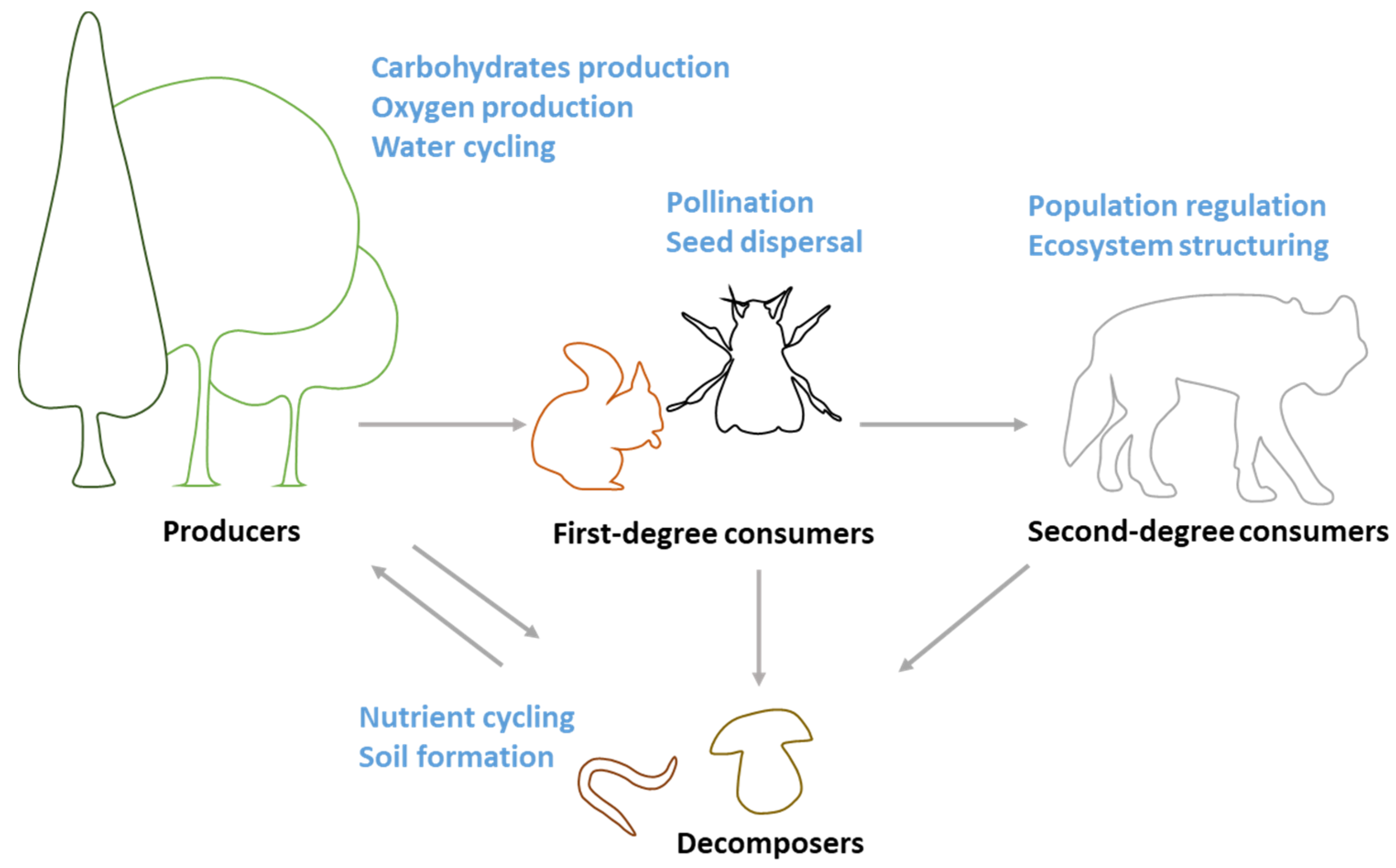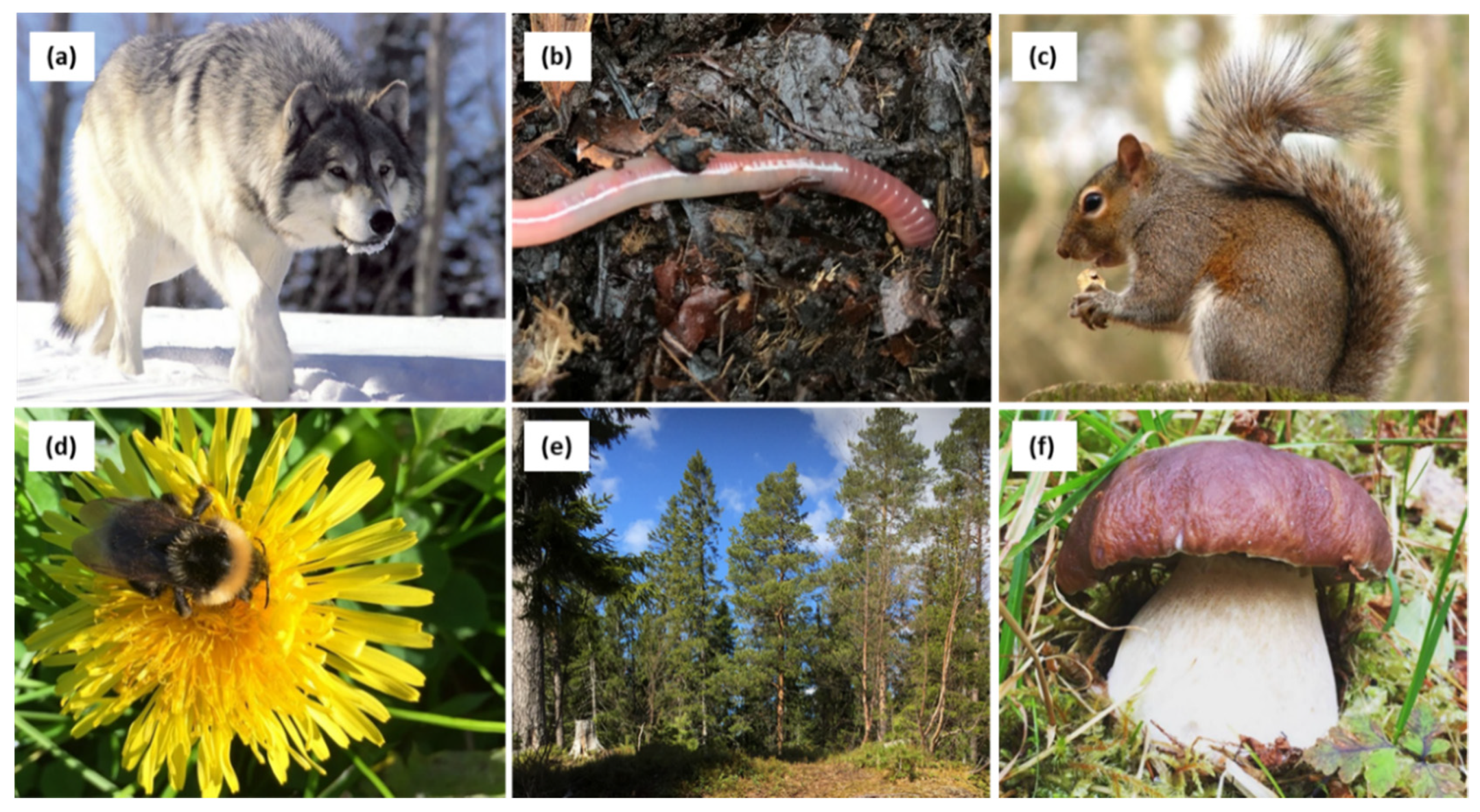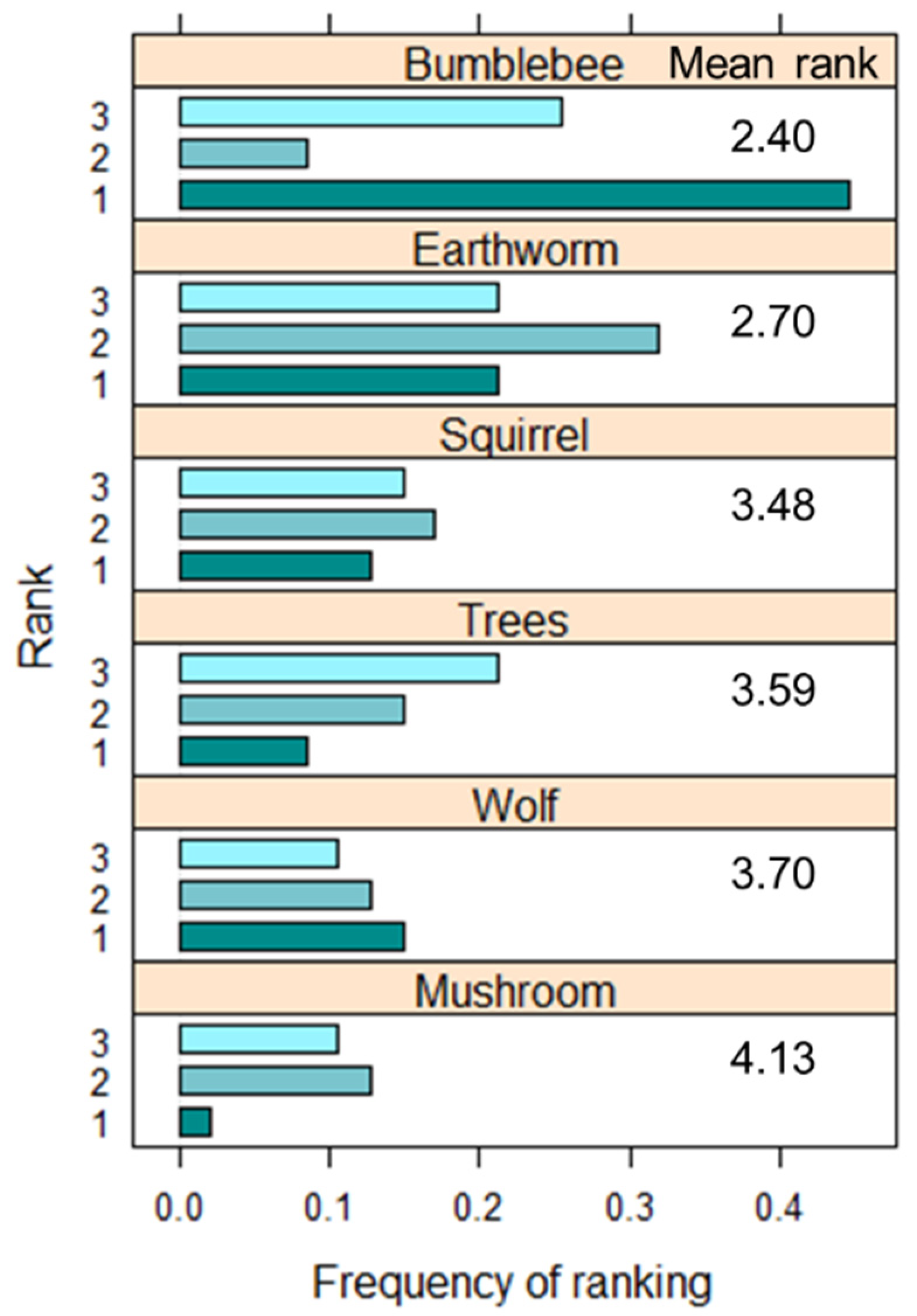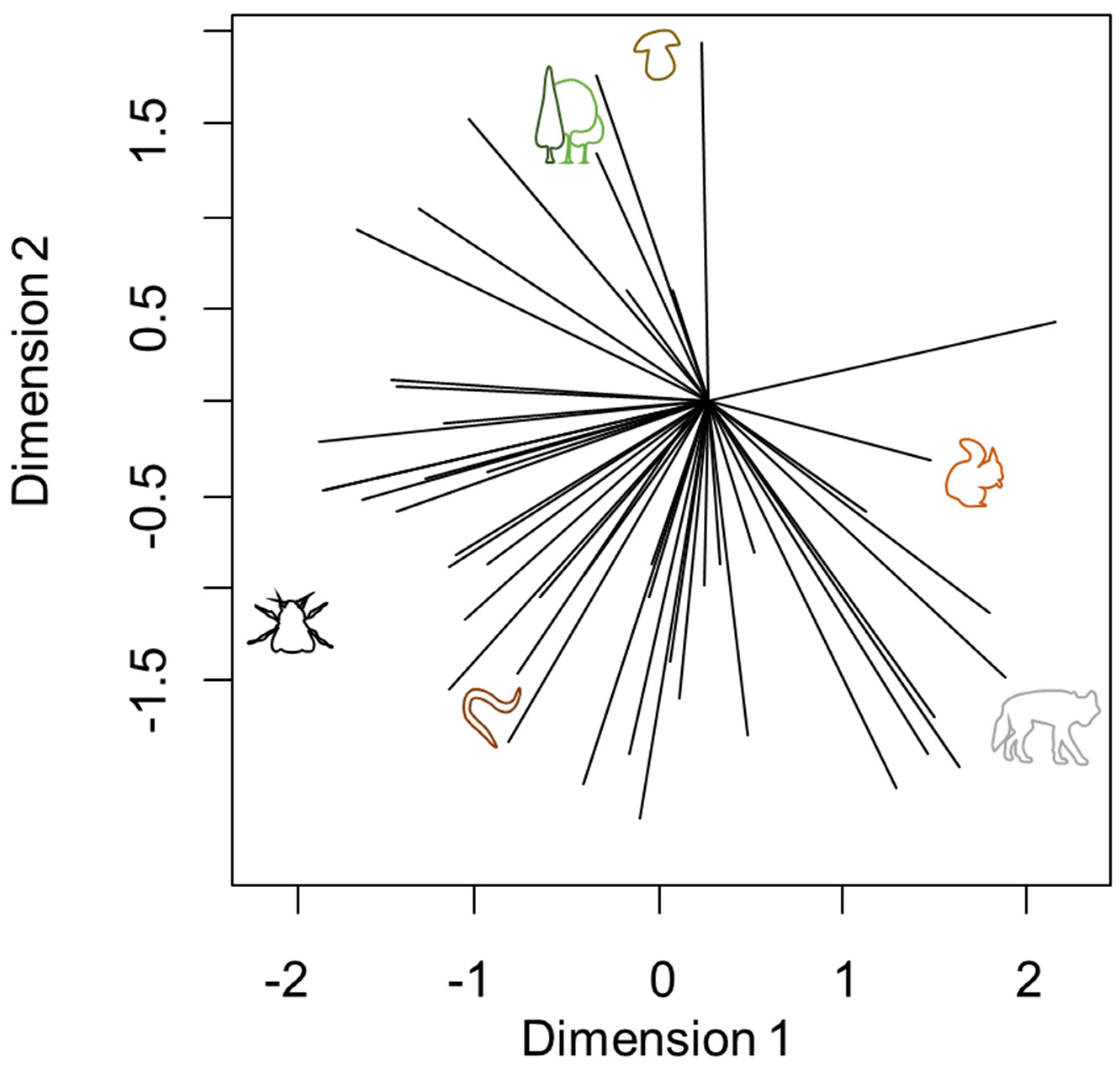Kindergarten Children’s Perception about the Ecological Roles of Living Organisms
Abstract
1. Introduction
1.1. Importance of Learning about How Ecosystems Work
1.2. What is the Role of Different Organisms in Food Webs?
1.3. Literature Review
1.4. Early Childhood Education in Norway
- Learn about nature and sustainable development;
- Gain an early understanding of nature conservation;
- Learn about animals and animal life.
1.5. Purpose of the Study
- How do young children rank the (relative) importance of living organisms?
- Are there differences in ranking between sexes?
- Are there differences in ranking between kindergarten profiles (ordinary vs. farm)?
- Do kindergarten children recognize the interdependence between living organisms?
2. Materials and Method
2.1. Ethical Considerations
2.2. Participating Kindergartens
2.3. Semi-Structured Interviews of the Children
2.4. Semi-Structured Interviews with Six Photos—Which of These Living Organisms is Most Important for Nature?
2.5. Data and Statistical Analyses
3. Results
3.1. Ranking of the Organisms
3.2. Children Ideas about the Importance of the Six Organisms for Nature
4. Discussion
Limitations of the Study
5. Conclusions
Author Contributions
Funding
Acknowledgments
Conflicts of Interest
References
- Hooper, D.U.; Chapin, F.S.; Ewel, J.J.; Hector, A.; Inchausti, P.; Lavorel, S.; Lawton, J.H.; Lodge, D.M.; Loreau, M.; Naeem, S.; et al. Effects of biodiversity on ecosystem functioning: A consensus of current knowledge. Ecol. Monogr. 2005, 75, 3–35. [Google Scholar] [CrossRef]
- IPBES. Global Assessment Report on Biodiversity and Ecosystem Services of the Intergovernmental Science-Policy Platform on Biodiversity and Ecosystem Services; IPBES Secretariat: Bonn, Germany, 2019. [Google Scholar]
- Tilman, D.; Clark, M. Global diets link environmental sustainability and human health. Nature 2014, 515, 518–522. [Google Scholar] [CrossRef]
- Chaudhary, A.; Kastner, T. Land use biodiversity impacts embodied in international food trade. Global Environ. Chang. 2016, 38, 195–204. [Google Scholar] [CrossRef]
- Millennium Ecosystem Assessment. Ecosystems and Human Well-being: Biodiversity Synthesis; World Resources Institute: Washington, DC, USA, 2005. [Google Scholar]
- Cafaro, P.; Primack, R. Species extinction is a great moral wrong. Biol. Conserv. 2014, 170, 1–2. [Google Scholar] [CrossRef]
- Stapp, W.B. The concept of environmental education. Environ. Educ. 1969, 1, 30–31. [Google Scholar] [CrossRef]
- Kopnina, H. Education for sustainable development (ESD): The turn away from ‘environment’ in environmental education? Environ. Educ. Res. 2012, 18, 699–717. [Google Scholar] [CrossRef]
- Kopnina, H. Revisiting Education for Sustainable Development (ESD): Examining Anthropocentric Bias Through the Transition of Environmental Education to ESD. Sustain. Dev. 2014, 22, 73–83. [Google Scholar] [CrossRef]
- Davis, J. Young Children, Environmental Education, and the Future. Early Child. Educ. J. 1998, 26, 117–123. [Google Scholar] [CrossRef]
- UNESCO. Shaping the Future We Want: UN Decade of Education for Sustainable Development 2005–2014; Final Report; UNESCO: Paris, France, 2014; Available online: https://unesdoc.unesco.org/ark:/48223/pf0000230171 (accessed on 14 October 2020).
- Balmford, A.; Clegg, L.; Coulson, T.; Taylor, J. Why conservationists should heed Pokemon. Science 2002, 295, 2367. [Google Scholar] [CrossRef]
- UN General Assembly. Transforming Our World: The 2030 Agenda for Sustainable Development; Technical Report No. A/RES/70/1; UN General Assembly: New York, NY, USA, 21 October 2015. [Google Scholar]
- Washinawatok, K.; Rasmussen, C.; Bang, M.; Medin, D.; Woodring, J.; Waxman, S.; Marin, A.; Gurneau, J.; Faber, L. Children’s Play with a Forest Diorama as a Window into Ecological Cognition. J. Cogn. Dev. 2017, 18, 617–632. [Google Scholar] [CrossRef]
- Domínguez-García, V.; Muñoz, M.A. Ranking species in mutualistic networks. Sci. Rep. 2015, 5, 8182. [Google Scholar] [CrossRef] [PubMed]
- Wandersee, J.H.; Schussler, E.E. Preventing plant blindness. Am. Biol. Teach. 1999, 61, 82–86. [Google Scholar] [CrossRef]
- Knapp, S. Are humans really blind to plants? Plants People Planet 2019, 1, 164–168. [Google Scholar] [CrossRef]
- Averill, C.; Turner, B.L.; Finzi, A.C. Mycorrhiza-mediated competition between plants and decomposers drives soil carbon storage. Nature 2014, 505, 543. [Google Scholar] [CrossRef]
- Averill, C.; Hawkes, C.V. Ectomycorrhizal fungi slow soil carbon cycling. Ecol. Lett. 2016, 19, 937–947. [Google Scholar] [CrossRef]
- Lange, L. The importance of fungi and mycology for addressing major global challenges. IMA Fungus 2014, 5, 463–471. [Google Scholar] [CrossRef]
- Rhodes, C.J. Mycoremediation (bioremediation with fungi)—Growing mushrooms to clean the earth. Chem. Spec. Bioavailab. 2014, 26, 196–198. [Google Scholar] [CrossRef]
- Medina-Sauza, R.M.; Alvarez-Jimenez, M.; Delhal, A.; Reverchon, F.; Blouin, M.; Guerrero-Analco, J.A.; Cerdan, C.R.; Guevara, R.; Villain, L.; Barois, I. Earthworms Building Up Soil Microbiota, a Review. Front. Environ. Sci. 2019, 7. [Google Scholar] [CrossRef]
- Blouin, M.; Hodson, M.E.; Delgado, E.A.; Baker, G.; Brussaard, L.; Butt, K.R.; Dai, J.; Dendooven, L.; Peres, G.; Tondoh, J.E.; et al. A review of earthworm impact on soil function and ecosystem services. Eur. J. Soil Sci. 2013, 64, 161–182. [Google Scholar] [CrossRef]
- Ollerton, J.; Winfree, R.; Tarrant, S. How many flowering plants are pollinated by animals? Oikos 2011, 120, 321–326. [Google Scholar] [CrossRef]
- Potts, S.G.; Biesmeijer, J.C.; Kremen, C.; Neumann, P.; Schweiger, O.; Kunin, W.E. Global pollinator declines: Trends, impacts and drivers. Trends Ecol. Evol. 2010, 25, 345–353. [Google Scholar] [CrossRef] [PubMed]
- Scaven, V.L.; Rafferty, N.E. Physiological effects of climate warming on flowering plants and insect pollinators and potential consequences for their interactions. Curr. Zool. 2013, 59, 418–426. [Google Scholar] [CrossRef] [PubMed]
- Lazaro, A.; Tur, C. Land-use changes as drivers of pollinator declines. Ecosistemas 2018, 27, 23–33. [Google Scholar] [CrossRef]
- Woodcock, B.A.; Heard, M.S.; Jitlal, M.S.; Rundlof, M.; Bullock, J.M.; Shore, R.F.; Pywell, R.F. Replication, effect sizes and identifying the biological impacts of pesticides on bees under field conditions. J. Appl. Ecol. 2016, 53, 1358–1362. [Google Scholar] [CrossRef]
- Schönfelder, M.L.; Bogner, F.X. Individual perception of bees: Between perceived danger and willingness to protect. PLoS ONE 2017, 12, e0180168. [Google Scholar] [CrossRef] [PubMed]
- Sergio, F.; Newton, I.; Marchesi, L.; Pedrini, P. Ecologically justified charisma: Preservation of top predators delivers biodiversity conservation. J. Appl. Ecol. 2006, 43, 1049–1055. [Google Scholar] [CrossRef]
- Simberloff, D. Flagships, umbrellas, and keystones: Is single-species management passe in the landscape era? Biol. Conserv. 1998, 83, 247–257. [Google Scholar] [CrossRef]
- Ripple, W.J.; Estes, J.A.; Beschta, R.L.; Wilmers, C.C.; Ritchie, E.G.; Hebblewhite, M.; Berger, J.; Elmhagen, B.; Letnic, M.; Nelson, M.P.; et al. Status and Ecological Effects of the World’s Largest Carnivores. Science 2014, 343, 151. [Google Scholar] [CrossRef]
- Gascon, C.; Brooks, T.M.; Contreras-MacBeath, T.; Heard, N.; Konstant, W.; Lamoreux, J.; Launay, F.; Maunder, M.; Mittermeier, R.A.; Molur, S.; et al. The Importance and Benefits of Species. Curr. Biol. 2015, 25, R431–R438. [Google Scholar] [CrossRef]
- Allen, M. Preschool Children’s Taxonomic Knowledge of Animal Species. J. Res. Sci. Teach. 2015, 52, 107–134. [Google Scholar] [CrossRef]
- Alanazi, F.H. Saudi Children’s Taxonomic Knowledge of Animal Species. J. Balt. Sci. Educ. 2018, 17, 395–413. [Google Scholar]
- Shepardson, D.P. Bugs, butterflies, and spiders: Children’s understandings about insects. Int. J. Sci. Educ. 2002, 24, 627–643. [Google Scholar] [CrossRef]
- Huxham, M.; Welsh, A.; Berry, A.; Templeton, S. Factors influencing primary school children’s knowledge of wildlife. J. Biol. Educ. 2006, 41, 9–12. [Google Scholar] [CrossRef]
- Borg, F.; Winberg, M.; Vinterek, M. Children’s Learning for a Sustainable Society: Influences from Home and Preschool. Educ. Inq. 2017, 8, 151–172. [Google Scholar] [CrossRef]
- Melis, C.; Wold, P.-A.; Bjørgen, K.; Moe, B. Norwegian Kindergarten Children’s Knowledge about the Environmental Component of Sustainable Development. Sustainability 2020, 12, 37. [Google Scholar] [CrossRef]
- Borg, F.; Winberg, T.M.; Vinterek, M. Preschool children’s knowledge about the environmental impact of various modes of transport. Early Child Dev. Care 2019, 189, 376–391. [Google Scholar] [CrossRef]
- Kingham, S.; Donohoe, S. Children’s perceptions of transport. World Transp. Policy Pract. 2002, 8, 6–10. [Google Scholar]
- Kahn Jr, P.H.; Kellert, S.R. Children and Nature: Psychological, Sociocultural, and Evolutionary Investigations; MIT Press: Cambridge, MA, USA, 2002; p. 348. [Google Scholar]
- Kahn, P.H.; Friedman, B. Environmental Views and Values of Children in an Inner-City Black-Community. Child Dev. 1995, 66, 1403–1417. [Google Scholar] [CrossRef]
- Cohen, S.; Horm-Wingerd, D.M. Children and the environment: Ecological awareness among preschool children. Environ. Behav. 1993, 25, 103–120. [Google Scholar] [CrossRef]
- Bang, M.; Medin, D.L.; Atrans, S. Cultural mosaics and mental models of nature. Proc. Natl. Acad. Sci. USA 2007, 104, 13868–13874. [Google Scholar] [CrossRef]
- Gallois, S.; Duda, R.; Reyes-García, V. Local ecological knowledge among Baka children: A case of “children’s culture”? J. Ethnobiol. 2017, 37, 60–80. [Google Scholar] [CrossRef] [PubMed]
- Ruiz-Mallen, I.; Morsello, C.; Reyes-Garcia, V.; De Faria, R.B.M. Children’s use of time and traditional ecological learning. A case study in two Amazonian indigenous societies. Learn. Individ. Differ. 2013, 27, 213–222. [Google Scholar] [CrossRef]
- Borgi, M.; Cirulli, F. Attitudes toward Animals among Kindergarten Children: Species Preferences. Anthrozoos 2015, 28, 45–59. [Google Scholar] [CrossRef]
- Kubiatko, M. Kindergarten childrens perception of animals focusing on the look and fear of animals. Educ. Sci. Theory Pract. 2012, 12, 3181–3186. [Google Scholar]
- Schuttler, S.G.; Stevenson, K.; Kays, R.; Dunn, R.R. Children’s attitudes towards animals are similar across suburban, exurban, and rural areas. PeerJ 2019, 7, e7328. [Google Scholar] [CrossRef]
- Kellert, S.R. Attitudes toward Animals: Age-Related Development among Children. J. Environ. Educ. 1985, 16, 29–39. [Google Scholar] [CrossRef]
- Leach, J.; Driver, R.; Scott, P.; Wood-Robinson, C. Children’s ideas about ecology 3: Ideas found in children aged 5-16 about the interdependency of organisms. Int. J. Sci. Educ. 1996, 18, 129–141. [Google Scholar] [CrossRef]
- Palmer, J.; Bajd, B.; Duraki, D.; Razpet, N.; Suggate, J.; Tsaliki, E.; Paraskevopoulos, S.; Dimec, D.S. Emerging knowledge of distant environments: An international study of four and six year olds in England, Slovenia and Greece. Eur. Early Child. Educ. Res. J. 1999, 7, 17–38. [Google Scholar] [CrossRef]
- Ballouard, J.M.; Brischoux, F.; Bonnet, X. Children Prioritize Virtual Exotic Biodiversity over Local Biodiversity. PLoS ONE 2011, 6. [Google Scholar] [CrossRef]
- Genovart, M.; Tavecchia, G.; Enseñat, J.J.; Laiolo, P. Holding up a mirror to the society: Children recognize exotic species much more than local ones. Biol. Conserv. 2013, 159, 484–489. [Google Scholar] [CrossRef]
- Snaddon, J.L.; Turner, E.C.; Foster, W.A. Children’s Perceptions of Rainforest Biodiversity: Which Animals Have the Lion’s Share of Environmental Awareness? PLoS ONE 2008, 3, e2579. [Google Scholar] [CrossRef]
- Directorate for Education and Training. The Education Mirror; The Norwegian Directorate for Education and Training: Oslo, Norway, 2017.
- Directorate for Education and Training. Framework Plan for Kindergartens; The Norwegian Directorate for Education and Training: Oslo, Norway, 2017.
- Moser, T.; Martinsen, M.T. The outdoor environment in Norwegian kindergartens as pedagogical space for toddlers’ play, learning and development. Eur. Early Child. Educ. Res. J. 2010, 18, 457–471. [Google Scholar] [CrossRef]
- Fjørtoft, I. The Natural Environment as a Playground for Children: The Impact of Outdoor Play Activities in Pre-Primary School Children. Early Child. Educ. J. 2001, 29, 111–117. [Google Scholar] [CrossRef]
- Perception. In Oxford Online Dictionary. 2019. Available online: https://www.lexico.com/definition/perception (accessed on 14 October 2020).
- Lee, P.H.; Yu, P.L.H. An R package for analyzing and modeling ranking data. BMC Med Res. Methodol. 2013, 13, 65. [Google Scholar] [CrossRef] [PubMed]
- R Core Team. R: A Language and Environment for Statistical Computing; R Foundation for Statistical Computing: Vienna, Austria, 2013. [Google Scholar]
- Gunnthorsdottir, A. Physical Attractiveness of an Animal Species as a Decision Factor for its Preservation. Anthrozoös 2001, 14, 204–215. [Google Scholar] [CrossRef]
- Kellert, S.R. Values and Perceptions of Invertebrates. Conserv. Biol. 1993, 7, 845–855. [Google Scholar] [CrossRef]
- Norwegian Ministries. National Pollinator Strategy; Norwegian Ministry of Agriculture and Food: Oslo, Norway, 2018; p. 52.
- Bjerke, T.; Ødegårdstuen, T.S.; Kaltenborn, B.P. Attitudes Toward Animals Among Norwegian Children and Adolescents: Species Preferences. Anthrozoös 1998, 11, 227–235. [Google Scholar] [CrossRef]
- Prøysen, A.; Øian, J. Nøtteliten. Philips: 1955. Available online: https://open.spotify.com/album/5Yhth8neg1NecBLLh66Vkv?highlight=spotify:track:43FGHSgNwSXdUWwEhUJXd4 (accessed on 14 October 2020).
- Wedge, C. Ice Age. Twentieth Century Fox: Los Angeles, CA, USA, 2002. Available online: https://family.20thcenturystudios.com/movies/ice-age (accessed on 14 October 2020).
- Stapanian, M.A. Seed dispersal by birds and squirrels in the deciduous forests of the United States. In Frugivores and Seed Dispersal; Springer: Dordrecht, Germany, 1986. [Google Scholar] [CrossRef]
- Allen, W. Plant Blindness. BioScience 2003, 53, 926. [Google Scholar] [CrossRef]
- Wandersee, J.; Schussler, E. Toward a theory of plant blindness. Plant Sci. Bull. 2001, 47, 2–9. [Google Scholar]
- Sanders, D.L. Making public the private life of plants: The contribution of informal learning environments. Int. J. Sci. Educ. 2007, 29, 1209–1228. [Google Scholar] [CrossRef]
- Amprazis, A.; Papadopoulou, P.; Malandrakis, G. Plant blindness and children’s recognition of plants as living things: A research in the primary schools context. J. Biol. Educ. 2019, 1–16. [Google Scholar] [CrossRef]
- Phenice, L.A.; Griffore, R.J. Young Children and the Natural World. Contemp. Issues Early Child. 2003, 4, 167–171. [Google Scholar] [CrossRef]
- White, P.J.; Garrott, R.A. Yellowstone’s ungulates after wolves—Expectations, realizations, and predictions. Biol. Conserv. 2005, 125, 141–152. [Google Scholar] [CrossRef]
- Boa, E.R. Wild Edible Fungi: A Global Overview of Their Use and Importance to People; Food and Agriculture Organization of the United Nations: Rome, Italy, 2004. [Google Scholar]
- Norsk Helseinformatikk, A.S. Førstehjelp ved Inntak av Giftig Sopp. Available online: https://nhi.no/forstehjelp/forgiftninger/giftig-sopp-inntak-av/?hp=true (accessed on 14 October 2020).
- Røskaft, E.; Bjerke, T.; Kaltenborn, B.; Linnell, J.D.C.; Andersen, R. Patterns of self-reported fear towards large carnivores among the Norwegian public. Evol. Hum. Behav. 2003, 24, 184–198. [Google Scholar] [CrossRef]
- Gelter, H. Friluftsliv: The Scandinavian Philosophy of Outdoor Life. Can. J. Environ. Educ. 2000, 5, 77–92. [Google Scholar]
- Washington, H.; Taylor, B.; Kopnina, H.; Cryer, P.; Piccolo, J.J. Why ecocentrism is the key pathway to sustainability. Ecol. Citiz. 2017, 1, 35–41. [Google Scholar]
- Taylor, B.; Chapron, G.; Kopnina, H.; Orlikowska, E.; Gray, J.; Piccolo, J.J. The need for ecocentrism in biodiversity conservation. Conserv. Biol. 2020, 34, 1089–1096. [Google Scholar] [CrossRef]




| Category | Normal (Eco-Certified) | Farm | Total |
|---|---|---|---|
| Kindergartens | 5 | 3 | 8 |
| Children | 37 | 19 | 56 |
| Girls | 19 | 9 | 28 |
| Boys | 18 | 10 | 28 |
Publisher’s Note: MDPI stays neutral with regard to jurisdictional claims in published maps and institutional affiliations. |
© 2020 by the authors. Licensee MDPI, Basel, Switzerland. This article is an open access article distributed under the terms and conditions of the Creative Commons Attribution (CC BY) license (http://creativecommons.org/licenses/by/4.0/).
Share and Cite
Melis, C.; Wold, P.-A.; Billing, A.M.; Bjørgen, K.; Moe, B. Kindergarten Children’s Perception about the Ecological Roles of Living Organisms. Sustainability 2020, 12, 9565. https://doi.org/10.3390/su12229565
Melis C, Wold P-A, Billing AM, Bjørgen K, Moe B. Kindergarten Children’s Perception about the Ecological Roles of Living Organisms. Sustainability. 2020; 12(22):9565. https://doi.org/10.3390/su12229565
Chicago/Turabian StyleMelis, Claudia, Per-Arvid Wold, Anna Maria Billing, Kathrine Bjørgen, and Børge Moe. 2020. "Kindergarten Children’s Perception about the Ecological Roles of Living Organisms" Sustainability 12, no. 22: 9565. https://doi.org/10.3390/su12229565
APA StyleMelis, C., Wold, P.-A., Billing, A. M., Bjørgen, K., & Moe, B. (2020). Kindergarten Children’s Perception about the Ecological Roles of Living Organisms. Sustainability, 12(22), 9565. https://doi.org/10.3390/su12229565






